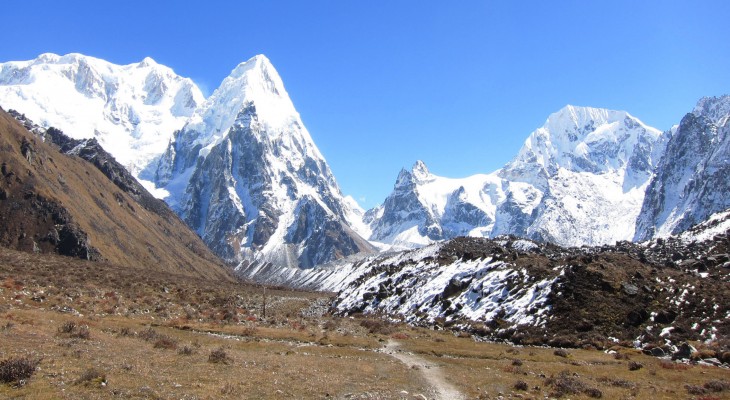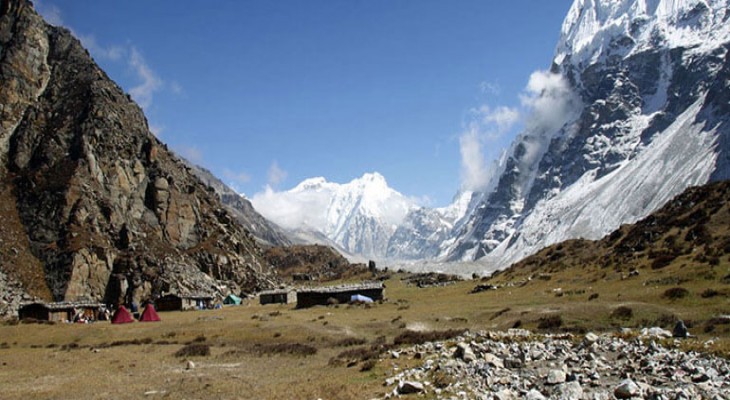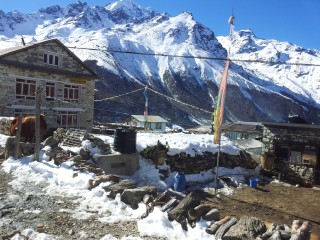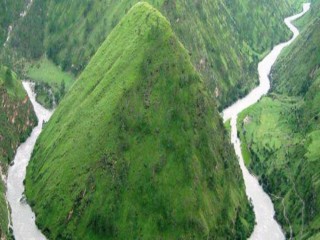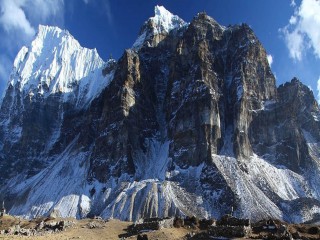Introduction
Kanchenjunga Trek is remote, wild and full of adventure. Named after Kanchenjunga Peak (8586m), the world’s third highest peak, the region is located in Taplejung District in the northeastern part of Nepal on the borders of Sikkim and Tibet. The area is well known for its three river valleys: the Simbua Khola, the Ghunsa and the Tamur valleys. In 1997, the Government of Nepal in support of WWF has declared the core area of Kanchenjunga region as a " Gift to the Earth".
The highlights of the Kanchenjunga trek are the magnificent views of Kanchenjunga Massif, varied landscapes of forests, rivers, glaciers and enchanting forests of rhododendrons. Spread in an area of 2035 sq. km., Kanchenjunga Conservation Area is another attraction of this trek where you will find rare and unique flora and fauna including rhododendrons, orchids, muck deer, snow leopard, Asiatic black bear, red panda etc. Kanchenjunga area is also a global hotspot for plant biodiversity and as many as 23 species of rhododendrons and over 2000 flowering plants have been identified here.
The Kanchenjunga Trek allows you to discover the unique local culture and lifestyle of the local people who live in tranquil villages that stretch beyond the border to Tibet and Sikkim. The region is rich in ethnic diversity and culture with over 11 ethnic communities including Limbus, Sherpa, Rai, Chhetri and Brahmins. The area also hosts a score of monasteries, chhortens, temples, prayer-walls which forms a tapestry of rich cultural heritage.
Kanchenjunga Trek is purely a camping trek. The trail gradually ascends from 1200m (4,000ft) to 5180m (17,094ft) above sea level. Climate in Kanchenjunga varies from subtropical monsoon and humid summer at the lower elevations to cold and wet winter in the alpine region. Along the way, you will walk along trails used by locals and yaks, while the main trek to Kanchenjunga has still been described as ‘untrekked’. We will also cross over several passes including Mirgin La pass which offers majestic views of Kanchenjunga Massif. Kanchenjunga Base Camp, Kanchenjunga South and North Trek, Kanchenjunga Circuit Trek some of the trekking routes available in this area.
Outline Itinerary
Day 1 Drive from Kathmandu to Basantpur via Dharan (428m.), Dhankuta (1158m.) and Hille (1822m.) by bus.
Day 2 Drive from Kathmandu to Basantpur via Dharan (428m.), Dhankuta (1158m.) and Hille (1822m.) by bus.
Day 3 Trek from Basantpur to Chauki (2400m.) takes about six hours.
Day 4 Trek from Chauki to Gupha Pokhari (2940m.) to Gurja Gaon(2145m.) takes about seven hours.
Day 5 Trek from Gurja Goan to Dovan (730 m.) takes approximately five and half hours.
Day 6 Trek from Dovan to Mitlung (921m.) takes approximately six hours.
Day 7 : Trek from Mitlung to Chirwa (1171m.) takes about seven hours.
Day 8 Trek from Chirwa to Sekathum (1635m.) takes about six hours.
Day 9 Trek from Sekathum to Amjilosa (2510m.) takes about five hours.
Day 10 Trek from Amjilosa to Gyable takes about seven hours.
Day 11 Trek from Gyable to Ghunsa (3468m.) takes about six hours.
Day 12 Rest day at Ghunsa for acclimatization.
Day 13 Trek from Ghunsa to Kambachen (4124m.) takes about seven hours.
Day 14 Trek from Kambachen to Lhonak (4780m.) takes about seven hours.
Day 15 Trek from Lhonak to pangpema (5152m.) takes about four hours.
Day 16 Trek from Pangpema to Kanchanjunga (North) Base Camp (5280m.) to Lhonak takes approximately six hours.
Day 17 Trek from Lhonak to Ghunsa takes about seven hours.
Day 18 Trek from Ghunsa to Mirgin La (4583m.) takes about seven hours.
Day 19 Trek from Mirgin La to Tseram (3725m.) takes about seven hours.
Day 20 Trek from Tseram to Oktang (5225m.) takes about eight hours.
Day 21 Excursion to Kanchanjunga Base Camp (South) takes about six hours.
Day 22 Trek from Oktang to Tseram (3725m.) This takes approximately seven hours.
Day 23 Trek from Tseram to Yamphudin (2090m.) takes about nine hours.
Day 24 Trek from Yamphudin to Khebang (1740m.) takes about seven hours.
Day 25 Trek from Khebang to Thorpu (1500m.) takes approximately nine hours.
Day 26 Trek from Thorpu to Gopetar (2250m.) takes about six hours.
Day 27 Drive from Gopetar to Kathmandu via Phidim (1264m.) and Ilam (1229m.).
Day 28 Drive from Gopetar to Kathmandu via Phidim (1264m.) and Ilam (1229m.).
Day 29 : Final departure
Day 1 : Drive from Kathmandu to Basantpur via Dharan (428m.), Dhankuta (1158m.) and Hille (1822m.) by bus.
Drive from Kathmandu to Basantpur via Dharan (428m.), Dhankuta (1158m.) and Hille (1822m.) by bus. Takes approximately 18 hours. You camp for the night.
Accomodation :
Day 2 : Drive from Kathmandu to Basantpur via Dharan (428m.), Dhankuta (1158m.) and Hille (1822m.) by bus.
Accomodation :
Day 3 : Trek from Basantpur to Chauki (2400m.) takes about six hours.
Trek from Basantpur to Chauki (2400m.) takes about six hours. The trail follows an uneven path. And the path is covered by rhododendron forests. If the sky is clear, you can enjoy panoramic views of Mount Makalu and Kanchenjunga Himal. On the way you also see some small human settlements. You can also view villages at some distance from your hiking point. Chauki is a small village with a few lodges and Nepali tea shops. You camp for the night.Accomodation :
Day 4 : Trek from Chauki to Gupha Pokhari (2940m.) to Gurja Gaon(2145m.) takes about seven hours.
Trek from Chauki to Gupha Pokhari (2940m.) to Gurja Gaon(2145m.) takes about seven hours. While trekking along this way, you pass through rhododendron forests. At one point, you come across a pass situated at 3000 meters. There is a pond at the Gupha Pokhari where prayer flags and Buddhist mani walls can be seen. On the way from Gupha Pokhari to Gurja Gaon, you can see yaks and mountain sheep grazing in the jungle. You will also observe some villages at a far distance. Gurja Gaon is inhabited by Buddhist and Hindus. It is situated at a low elevation. You camp for the night.Accomodation :
Day 5 : Trek from Gurja Goan to Dovan (730 m.) takes approximately five and half hours.
Trek from Gurja Goan to Dovan (730 m.) takes approximately five and half hours. The trail descends to Dovan and while en route you pass through jungle and villages. You trek through terraces where crops such as wheat, maize, rice, millet and potatoes are grown. Dovan is a village situated at a low elevation between two streams. You camp for the night.Accomodation :
Day 6 : Trek from Dovan to Mitlung (921m.) takes approximately six hours.
Trek from Dovan to Mitlung (921m.) takes approximately six hours. Crossing a suspension bridge over Tamur River you follow quite a flat route. Your hike continues along the bank of the Tamur Koshi through paddy fields. You frequently cross through small jungles of cardamom plants and other natural vegetation. You can see some small villages stretching at a far distance. The area is inhabited by the Brahmin, Chhetri and Limbu communities. You camp for the night.Accomodation :
Day 7 : : Trek from Mitlung to Chirwa (1171m.) takes about seven hours.
Trek from Mitlung to Chirwa (1171m.) takes about seven hours. The path to follow is quite narrow and passes through jungle mainly covered with cardamom plants and other vegetation. You can also see small gardens of oranges on your way. You cross through some small streams while trekking. Your trek leads through an undulating path. Chirwa is a small town where you find small lodges and a camping site with local shops. The local folks here are mainly engaged in agricultural activities. You camp for the night.Accomodation :
Day 8 : Trek from Chirwa to Sekathum (1635m.) takes about six hours.
Trek from Chirwa to Sekathum (1635m.) takes about six hours. Your trek passes through a small jungle along the bank of a river. You find the plants of cardamom and other different vegetation. You cross a small hanging bridge before you reach Sekhathum. You spend the night in camp.Accomodation :
Day 9 : Trek from Sekathum to Amjilosa (2510m.) takes about five hours.
Trek from Sekathum to Amjilosa (2510m.) takes about five hours. The first one and half-hours you trek along flat land. Your trail then becomes a steep ascent up to Amjilasa. Amjilassa is a small village with a few houses and yak herds and local shops where you can find minimal supplies. You camp for the night.Accomodation :
Day 10 : Trek from Amjilosa to Gyable takes about seven hours.
Trek from Amjilosa to Gyable takes about seven hours. The trail is quite flat in the beginning and then gently ascends to Gyable passing through the jungle. Human settlements are visible at Gyable. People living here follow the Buddhist culture. You stay overnight in camp.Accomodation :
Day 11 : Trek from Gyable to Ghunsa (3468m.) takes about six hours.
Trek from Gyable to Ghunsa (3468m.) takes about six hours. Your trail passes through a dense green jungle. You can see Gunsa River down the trail. The trail passes through a few human settlements and it is clearly visible that their life styles and culture has been inherited from Tibet. You pass through terraced fields where potatoes, wheat, barley and buck wheat are grown. You camp for the night.Accomodation :
Day 12 : Rest day at Ghunsa for acclimatization.
Rest day at Ghunsa for acclimatization. This is a day to rest and acclimatize and do some excursions in and around Ghunsa. Gunsa is rich with Tibetan and Buddhist culture and is a relatively larger town inhabited by Tibetan people. The women are mainly involved in the carpet weaving profession and almost all homes engage in carpet weaving. Trekkers come across a few check points at Ghunsa. There are also local shops where you can buy goods to take along with you to the higher altitudes. You camp for the night.Accomodation :
Day 13 : Trek from Ghunsa to Kambachen (4124m.) takes about seven hours.
Trek from Ghunsa to Kambachen (4124m.) takes about seven hours. The trail makes a gradual ascent along the south bank of the Gunsa Khola, then crosses a boulder strewn flood plain before crossing back to Rambuk Kharka on the north side of the river. Once on the opposite side, the trail passes a waterfall then makes a short, steep ascent to a very unstable slope. The trail drops to the single locked hut at Lakep, and then traverses to Khambachen, a Tibetan settlement of about a dozen houses at 4040m. You camp for the night.Accomodation :
Day 14 : Trek from Kambachen to Lhonak (4780m.) takes about seven hours.
Trek from Kambachen to Lhonak (4780m.) takes about seven hours. The trail climbs gradually through open rocky fields to Ramtang at 4240m, then across moraines north-west of the Kanchenjunga Glacier. Lhonak, at 4790m, is near a dry lake bed on an open, sandy plain; water is scarce here. There are no houses, but you can camp among the large boulders to get out of the wind. Terrific mountain views abound in all directions. Stay overnight in camp.Accomodation :
Day 15 : Trek from Lhonak to pangpema (5152m.) takes about four hours.
Trek from Lhonak to pangpema (5152m.) takes about four hours. From Lhonak, the trail ascends gradually across the plain, and then gets a bit steeper as it follows the moraine. You follow the bottom of the valley to avoid the steeper section. The views are dramatic, but you cannot see Kanchenjunga or Wedge Peak until you are near Peng Pema. The spectacular main peak of Kanchenjunga, and a panorama of other peaks that make up one of the largest mountain masses in the world, tower over the single roofless hut at Pang Pema. You camp for the night.Accomodation :
Day 16 : Trek from Pangpema to Kanchanjunga (North) Base Camp (5280m.) to Lhonak takes approximately six hours.
Trek from Pangpema to Kanchanjunga (North) Base Camp (5280m.) to Lhonak takes approximately six hours. Here you can enjoy the snowcapped mountains and the Kanchenjunga glacier. During the middle of the day, the falling avalanches totally captivate you. You camp for the night.Accomodation :
Day 17 : Trek from Lhonak to Ghunsa takes about seven hours.
Trek from Lhonak to Ghunsa takes about seven hours. Now you trek along a descending path, crossing the jungle along the Kambachen River. In some places you can see mani walls and prayer flags hanging over the trees. Also at one point, you have to cross a wooden bridge. You camp for the night.Accomodation :
Day 18 : Trek from Ghunsa to Mirgin La (4583m.) takes about seven hours.
Trek from Ghunsa to Mirgin La (4583m.) takes about seven hours. By ascending, you pass through a jungle. While trekking, you can also catch glimpses of the various mountains along with again enjoying the mani walls and prayer flags which are hanging over the trees. You can spot various animals like mountain goats and yaks grazing over the green hills. You camp for the night.Accomodation :
Day 19 : Trek from Mirgin La to Tseram (3725m.) takes about seven hours.
Trek from Mirgin La to Tseram (3725m.) takes about seven hours. You trek through almost desert like areas and in some places you will cross a stony path. The path ascends from Mirgin La to Tseram. On the path, you can see Lapsang La glacier, Mirgin La glacier and snow-capped mountains. There are very few stone roof houses at Tseram and also some yak huts. You stay overnight in camp.Accomodation :
Day 20 : Trek from Tseram to Oktang (5225m.) takes about eight hours.
Trek from Tseram to Oktang (5225m.) takes about eight hours. Today you trek through moraines. On the trail, you can see the Yalung glacier and Lapsang glacier. You can also see mountain goats as you cross a desert like area. The view of snow-covered mountains and Kanchenjunga is absolutely magnificent. You camp for the night.Accomodation :
Day 21 : Excursion to Kanchanjunga Base Camp (South) takes about six hours.
Excursion to Kanchanjunga Base Camp (South) takes about six hours. Trekkers have to walk through moraines and a strenuous rocky path. Trekking this day is pretty adventurous as you have to walk along and cross the Oktang glacier. The panoramic views of Kanchenjunga and Mount Jannu will mesmerize you. Some parts of this area touch the neighboring India. You camp for the night.Accomodation :
Day 22 : Trek from Oktang to Tseram (3725m.) This takes approximately seven hours.
Trek from Oktang to Tseram (3725m.) This takes approximately seven hours. You trek following a stream alongside the moraines of Yalung Glacier. The path is quite loose and rocky. Mani walls and prayer flags will be seen hanging over the trees. Along the way, you will see the difficult route of Lapsang La pass at a distance. There are very few stone roof houses at Tseram and some yak huts. Stay overnight in camp.Accomodation :
Day 23 : Trek from Tseram to Yamphudin (2090m.) takes about nine hours.
Trek from Tseram to Yamphudin (2090m.) takes about nine hours. The first part of the trail goes along the bank of the river Simbua Khola. You have to walk through a dense jungle. On the way, you can see the effects of a landslide in some places. The trail ascends to Lamite Bhanjyang and then descends to Yamphudin crossing a small river. Yamphudin is a mixed community of Sherpas, Limbus, Rais and Gurungs. Among the corn and rice fields of the village there is a school and some shops with minimal supplies. Stay overnight in camp.Accomodation :
Day 24 : Trek from Yamphudin to Khebang (1740m.) takes about seven hours.
Trek from Yamphudin to Khebang (1740m.) takes about seven hours. In the beginning, you descend to cross the Omje Khola. Now you ascend through a jungle of cardamom and orchid plants. You pass a small village where you can find different human settlements, small thatched roof houses and local shops with minimal supplies. From here, the trail ascends up to Khebang Danda and then you descend to Khebang village. Khabang is a comparatively big village where the local people follow the Hindu and Buddhism faiths. Stay overnight in camp.Accomodation :
Day 25 : Trek from Khebang to Thorpu (1500m.) takes approximately nine hours.
Trek from Khebang to Thorpu (1500m.) takes approximately nine hours. The trail starts descending to Jorepul and then begins to ascend. You also trek along the flat and low land crossing paddy fields and thatched roof houses. There are many villages on the way where you can buy things you may require from the shops in these villages. Thorpu is a town where transportation facilities are available. Stay overnight in camp.Accomodation :
Day 26 : Trek from Thorpu to Gopetar (2250m.) takes about six hours.
Trek from Thorpu to Gopetar (2250m.) takes about six hours. You start off ascending through small villages up to the last destination, Gopetar. It is a town with a few small restaurants, teashops and some local bars. From here, you get on your bus to reach Phidim and finally on to Ilam. Stay overnight in camp.Accomodation :
Day 27 : Drive from Gopetar to Kathmandu via Phidim (1264m.) and Ilam (1229m.).
Drive from Gopetar to Kathmandu via Phidim (1264m.) and Ilam (1229m.).Accomodation :
Day 28 : Drive from Gopetar to Kathmandu via Phidim (1264m.) and Ilam (1229m.).
Drive from Gopetar to Kathmandu via Phidim (1264m.) and Ilam (1229m.).Accomodation :
Day 29 : : Final departure
Your adventure in Nepal comes to an end today! There is nothing to do but trade emails with your travel companions and organize your photos. A representative fromJvill nepal Trekking will take you to the airport, approximately 3 hours before your scheduled flight. On your way home you'll have plenty of time to plan your next adventure in the wonderful country of Nepal.Accomodation :
Features Included on Kanchenjunga Trek
Features Not Included on Kanchenjunga Trek
Things To know
Requirement
Equipments & Packing List
This list is a guideline to help you pack for your adventure. Also understand that the items listed below will vary a little according to the season and the trek duration. Those items marked by an asterisk (*) are provided by Himalayan Glacier inclusive in the service. The weight limit for your luggage is 33 pounds or 15 kg. Remember that your luggage will be carried by your porter but you are required to carry a day-pack (with your valuables or anything important) on your own. We also suggest that you pack only what is necessary.
Important documents and items
- Valid passport, 2 extra passport size photos, airline tickets
- Separate photocopies of passport, visa form (easily obtained at Kathmandu airport), proof of insurance
- Dollars, pounds or Euros in cash for purchasing Nepalese visa at Kathmandu airport, for paying for restaurants and hotels, for gratuities, snacks, and to purchase your own drinks and gifts
- Credit cards, Bank/ATM/Cash machine cards for withdrawing funds from cash machines (bring a photocopy of your cards), traveler's checks, etc.
Head
- Bandana or head scarf, also useful for dusty conditions
- Warm hat that covers your ears (wool or synthetic)
- Headlamp with extra batteries and bulbs
- Sunglasses with UV protection
- Prescription sunglasses (if required)
Upper Body
- Polypropylene shirts (1 half sleeve and 2 long sleeves)
- Light and expedition weight thermal tops
- Fleece wind-stopper jacket or pullover
- Waterproof (preferably breathable fabric) shell jacket
- Down vest and/or jacket *
- Gore-Tex jacket with hood, waterproof and breathable
Hands
- 1 pair of lightweight poly-liner gloves.
- 1 pair of lightweight wool or fleece gloves
- 1 pair of mittens, consists of 1 Gore-Tex over mitt matched with a very warm polar-fleece mitt liner (seasonal)
Lower Body
- Non-cotton underwear briefs
- 1 pair of Hiking shorts
- 1 pair of Hiking trousers
- 1 pair of lightweight thermal bottoms (seasonal)
- 1 pair of fleece or woolen trousers
- 1 pair of waterproof shell pants, breathable fabric
Feet
- 2 pairs of thin, lightweight inner socks
- 2 pairs of heavy poly or wool socks
- 1 pair of Hiking boots with spare laces (sturdy soles, water resistant, ankle support, “broken in”)
- 1 pair of trainers or running shoes and/or sandals
- Cotton socks (optional)
- Gaiters (winter only), optional, “low” ankle high version
Sleeping
- 1 sleeping bag (good to -10 degrees C or 14 degrees F)*
- Fleece sleeping bag liner (optional)
Rucksack and Travel Bags
- 1 medium rucksack (50-70 liters/3000-4500 cubic inches, can be used for an airplane carryon)
- 1 large duffel bag *
- A small daypack/backpack for carrying your valuables, should have good shoulder padding
- Small padlocks for duffel-kit bags
- 2 large waterproof rucksack covers (optional)
Medical
- Small, personal first-aid kit. (simple and light)
- Aspirin, first-aid tape, and plasters (Band-Aids)
- 1 skin-blister repair kit
- Anti-diarrhea pills
- Anti-headache pills
- Cough and/or cold medicine
- Anti-altitude sickness pills: Diamox or Acetylzolamide
- Stomach antibiotic: Ciprofloxacin, etc. Do not bring sleeping pills as they are a respiratory depressant.
- Water purification tablets or water filter
- 1 set of earplugs
- Extra pair of prescription glasses, contact lens supplies
Practical Items
- 1 small roll of repair tape, 1 sewing-repair kit
- 1 cigarette lighter, 1 small box of matches
- 1 compass or GPS(optional)
- 1 alarm clock/watch
- 1 digital camera with extra cards and batteries
- large Ziplocs
- 2 water bottles (1 liter each)
- 1 small folding knife
- Binoculars (optional)
- 4 large, waterproof, disposable rubbish sacks
Toiletries
- 1 medium-sized quick drying towel
- Toothbrush/paste (preferably biodegradable)
- Multi-purpose soap (preferably biodegradable)
- Deodorants
- Nail clippers
- Face and body moisturizer
- Female hygiene products
- Small mirror
Personal Hygiene
- Wet wipes (baby wipes)
- Tissue /toilet roll
- Anti-bacterial hand wash

